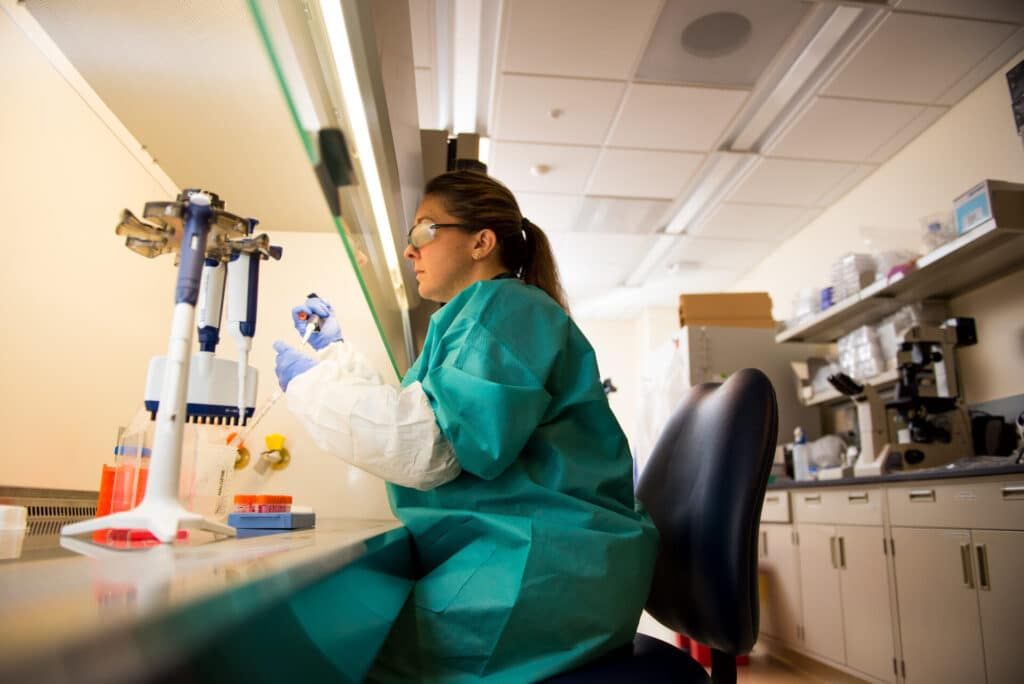How to tell biodefense from an offensive bioweapons program
By Dan Regan, Rhys Dubin | March 23, 2023
 Biodefense research at the Pacific Northwest National Laboratory. Andrea Starr/Pacific Northwest National Laboratory. CC BY-NC-SA 2.0.
Biodefense research at the Pacific Northwest National Laboratory. Andrea Starr/Pacific Northwest National Laboratory. CC BY-NC-SA 2.0.
For nearly three years, the world has faced a remarkable cascade of public health crises. As COVID-19, the rapid spread of mpox to more than 100 non-endemic countries, reemergent Ebola outbreaks, and a host of other threats demonstrate, biological risks are on the rise. Contrary to initial expectations, however, these disasters have not produced a simultaneous rise in global cooperation. As tensions spiked in the midst of Russia’s invasion of Ukraine, for instance, Moscow falsely accused the United States of constructing and running a series of biological weapons labs in Ukraine. Longstanding research facilities dedicated to public health research on endemic diseases were, according to Moscow, a cover for US-sponsored efforts to weaponize pathogens and even send infected animals like bats and insects into Russia.
This devastating combination of disease, conflict, and blatant misinformation makes biodefense—global efforts to counter biological threats, reduce biological risks, and prepare and respond to natural or artificial biological incidents—more vital than ever. Without effective policies, the United States and others stand exposed to numerous catastrophic threats, including everything from the next COVID-19 variant to biological weapons developed by violent non-state actors. Articulating a cohesive strategy is only half the battle. Because militaries may fund and be involved in biodefense efforts—which can require work on dangerous pathogens with partners in the far-flung locales—such programs are uniquely vulnerable to being misconstrued as bioweapons research, as recent Russian behavior demonstrates. Because of an exponential growth in disinformation efforts worldwide and increasing geopolitical tensions, it is more important than ever for governments to be crystal clear about what defensive biological programs look like, in contrast to offensive actions banned under international law.
In this regard, the Biden administration’s inclusion of counter-disinformation measures within its updated biodefense strategy is encouraging. Still, continuing to make the distinction between offense and defense is a vital step toward a comprehensive approach to biodefense. By drawing such a line, governments can effectively build trust, prepare for future threats, and call out rogue actors. Without such distinctions, however, Washington and others risk drowning in a sea of misinformation, which undermines global public health efforts and places them at grave risk.
What’s biodefense? Despite its sometimes-shadowy reputation, biodefense is integral to any comprehensive national security strategy. Most biodefense programs have a similar portfolio of activities meant to deter, detect, and respond to emerging threats.
Any successful biodefense program, for instance, will rely heavily on information gathering to detect emerging biological threats. Identifying such patterns is critical at all levels of government. Doing so can alert physicians to new diseases, inform decision-making on strategic national stockpiles, and even catalyze global health aid. In the United States, these activities span multiple programs, including the Pentagon’s Global Emerging Infections Surveillance and the Department of Health’s Center for Forecasting and Outbreak Analytics, which provide information on emerging pathogens, identify potential outbreaks, and model the likely spread of diseases.
Governments must also invest in biomedical equipment to prevent and contain infectious disease outbreaks. National defense and public health laboratories research improved personal protective equipment, advanced area decontamination, and other topics. Although information on most of these projects is publicly available, some may be classified to prevent malign actors from reverse engineering or circumventing valuable defensive measures.
Developing early warning systems to detect novel or reemerging pathogens is another critical part of biodefense programs. These may involve actively testing at-risk human, animal, and plant populations and taking regular environmental samples for infectious diseases. Governments also use electronic databases such as syndromic surveillance networks that monitor clinical data, including emergency room logs, mobile health apps, and social media—to look for indicators of outbreaks. Within the United States, clinicians, public health departments, state health departments, and the CDC all work together to monitor and detect potentially dangerous pathogens.
Finally, strong national biodefense programs rely on logistics and infrastructure to quickly deploy medical countermeasures in case of an outbreak. In the United States, the Biomedical Advanced Research and Development Authority (BARDA) plays a central role in these efforts—supporting the development and acquisition of medical countermeasures such as therapeutics and vaccines. The Department of Defense also plays a leading role in developing similar tools. The Pentagon was a key leader in Washington’s medical response to the 2014–2016 Ebola outbreak in West Africa and was instrumental in administering the US COVID-19 vaccination strategy.
Crucially, none of these biodefense activities—intelligence, equipment development, early warning, and logistics—are necessarily constrained by national borders. As far back as the 1940s, for instance, the United States partnered with countries across the former Soviet bloc, Southeast Asia, the Middle East, and Africa to bolster international biodefense capacities. With assistance from the US Biological Threat Reduction Program, partner countries receive training on field epidemiology and safe handling of infectious pathogens and funding to bolster their laboratories for pathogen diagnostic capabilities.
Defense versus offense. The United States’ contemporary biodefense posture differs observably from past examples of offensive biological programs designed to develop weapons. Although such large-scale bioweapons programs are comparatively rare, analysts and historians have documented multiple instances of states developing or using such weapons.
The Soviet Union, for instance, spent decades during the Cold War weaponizing a slate of deadly pathogens, even though it signed the Biological Weapons Convention, the global bioweapons ban, in 1975. Even after the treaty entered into force, the Soviets carried out extensive work to transform a variety of pathogens, including smallpox, plague, Marburg hemorrhagic fever, and a host of novel biological agents into weapons. Crucially, the Soviet government worked to produce these deadly agents on an industrial scale, constructing extensive secret facilities for making and amassing biological weapons.
Separately, in one of the few examples of a state actually using bioweapons in conflict, Japan deployed several different weaponized biological agents against Chinese and Soviet soldiers and civilians during World War II. On several occasions, Japanese aircraft deliberately dropped packages of rice and wheat contaminated with plague-carrying fleas, causing hundreds (if not thousands) of casualties across parts of China. In other instances, Japanese soldiers contaminated water supplies with cholera and spread anthrax in rice fields, among other biological attacks.
Although biological weapons are easier to identify when deployed in a comparatively obvious fashion, offensive programs are often difficult to verify or distinguish from defensive efforts. In contrast to the treaty governing chemical weapons, the Biological Weapons Convention does not have a formal verification regime designed to catch violators.
Official verification efforts notwithstanding, determining whether a particular state’s biological research program is offensive or defensive is a complex undertaking. Given rapid advances in biotechnology, many cutting-edge developments have dual-use potential—valuable for both peaceful research and theoretical weaponization, with little apparent difference to an outside observer. That doesn’t mean it is impossible to tell the difference, but it does mean that any serious attempt to separate offensive from defensive biological programs must rely on “probabilistic verification,” or the aggregation of many low- to medium-confidence strands of information. Outside analysts might, for instance, note a state’s sudden increase in secrecy around its biological research output, an unexpected shift in a government’s biodefense posture, an increase in particular acquisitions from the private sector, or a ramp-up in disinformation campaigns targeting rival states’ biological research activities. Together, these might provide grounds for serious suspicion.
Time to prepare. The need for a comprehensive global biodefense effort has never been clearer. COVID-19, mpox, and Ebola have taken their tolls on national economies and human health, serving as painful reminders of what can happen when states are left unprepared to handle complex emerging threats. But biodefense is far from a geopolitically neutral issue. Russia’s ongoing global disinformation campaign targeting US biodefense-support efforts in Ukraine and elsewhere illustrate the practical difficulties facing policymakers as they address biological threats. Given the often blurry and complex line between offensive and defensive programs, Washington risks getting bogged down in endless and self-defeating diplomatic spats if it is not crystal clear about both its intentions and the fundamentally defensive nature of its efforts.
Perhaps more dangerously, if the United States fails to provide clear explanations for shifts in its biodefense policies or posture, other nations may misinterpret the intent of such programs while competitors may leverage the ambiguity for disinformation campaigns. Because defensive research and testing may, at first pass, look similar to weaponization, foreign governments might mistakenly view such programs as signs of a Soviet Union-esque offensive effort—thereby prompting potentially catastrophic geopolitical miscalculation. Worse still, bad actors might exploit this ambiguity to justify using dangerous weapons themselves. Transparency and diplomacy will be key to avoiding such hazardous outcomes.
Threats in the biological realm aren’t going away anytime soon. Novel pathogens such as COVID-19 will continue to emerge, while older diseases such as dengue, mpox, and Ebola may reappear and spread further afield due to climate change. The US State Department has also assessed that Russia and North Korea have ongoing offensive biological weapons programs and that China and Iran engage in activities that raise concerns around compliance with the BWC. As geopolitical competition ramps up, these programs will only become more and more dangerous.
Given this shift in the biological threat landscape, Washington has good reason to focus on biodefense. But if policymakers want to bolster norms against biological weapons and avoid spiraling distrust and potential conflict, they must simultaneously take care to broadcast their intentions with as much clarity as possible. Although divining intent in geopolitics is a fraught exercise, offensive and defensive biological programs still look different—even from the outside. The Biden administration and those that come after must be careful to explain the distinction. If executed successfully, transparent US leadership might constitute a small step toward a world where biological weapons are obsolete.
Together, we make the world safer.
The Bulletin elevates expert voices above the noise. But as an independent nonprofit organization, our operations depend on the support of readers like you. Help us continue to deliver quality journalism that holds leaders accountable. Your support of our work at any level is important. In return, we promise our coverage will be understandable, influential, vigilant, solution-oriented, and fair-minded. Together we can make a difference.
Keywords: BWC, COVID-19, biodefense, bioweapons
Topics: Biosecurity
















